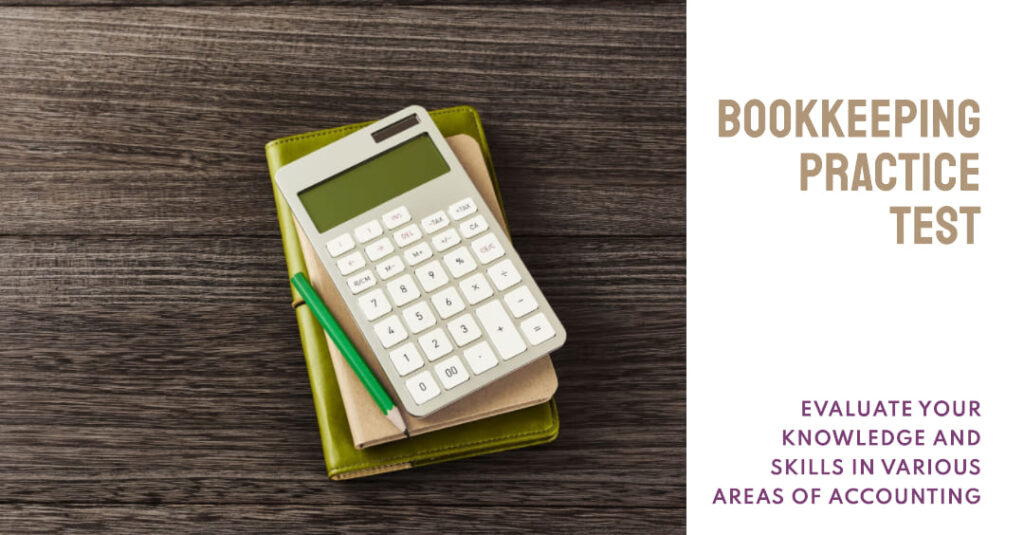Bookkeeping Practice Test
In context with Bookkeeping Practice Test, This practice test is designed to assess your knowledge and skills in various areas of bookkeeping. The test will cover topics such as accounting principles and concepts, journal entries and posting, trial balance and adjusting entries, financial statements preparation, bank reconciliation and cash management, accounts receivable and accounts payable, and payroll processing and taxation. The test will include multiple-choice questions, calculations, and scenario-based problems to evaluate your understanding and application of bookkeeping principles. By taking this practice test, you can assess your proficiency in bookkeeping and identify areas for improvement, helping you enhance your skills and prepare for bookkeeping-related roles or exams.
In context with Bookkeeping Practice Test, Accounting principles and concepts are the fundamental guidelines and rules that govern the field of accounting. These principles ensure that financial information is recorded, reported, and interpreted accurately and consistently. Some common accounting principles include the accrual principle, going concern principle, consistency principle, materiality principle, and conservatism principle. These principles provide a framework for recording and presenting financial transactions and help ensure the reliability and comparability of financial statements.
Journal Entries and Posting:
In context with Bookkeeping Practice Test, Journal entries are the first step in the accounting cycle and involve recording financial transactions in chronological order. A journal entry consists of the date, accounts affected, amounts debited or credited, and a brief description of the transaction. These entries are typically recorded in a journal or general ledger.
In context with the Bookkeeping Practice Test, Posting refers to the process of transferring information from journal entries to general ledger accounts. It involves updating the account balances by recording the debits and credits from the journal entries into the respective ledger accounts. This step is important to maintain accurate and up-to-date financial records.
Trial Balance and Adjusting Entries:
In context with Bookkeeping Practice Test, A trial balance is a summary of all the general ledger account balances, both debit and credit, at a specific point in time. It helps verify the accuracy of the recorded transactions by ensuring that the total debits equal the total credits. The trial balance is prepared before making adjusting entries.
Adjusting entries are made at the end of an accounting period to ensure that the financial statements reflect the true financial position and results of operations. These entries are used to record revenue or expenses that have been earned or incurred but not yet recorded, as well as to allocate prepaid or accrued expenses and revenues. Adjusting entries are necessary to comply with the matching principle and accrual accounting.
Financial Statements Preparation:
In context with Bookkeeping Practice Test, Financial statements are formal reports that provide an overview of an organization’s financial position, performance, and cash flows. The main financial statements include the balance sheet, income statement, statement of cash flows, and statement of changes in equity.
The balance sheet presents the company’s assets, liabilities, and shareholder’s equity at a specific date. The income statement shows the company’s revenues, expenses, and net income or loss over a period of time. The statement of cash flows provides information about the company’s cash inflows and outflows during a specific period. The statement of equity changes details the shareholders’ equity changes over a period.
To prepare financial statements, the accountant gathers information from various sources such as trial balances, adjusting entries, and additional supporting documentation. This information is then organized and presented in accordance with the applicable accounting standards and regulations.
In context with Bookkeeping Practice Test, Bank reconciliation is the process of comparing the balances in an organization’s accounting records with the balances shown on the bank statement. It ensures that the company’s records match the bank’s records and helps identify any discrepancies or errors. Bank reconciliations typically involve reconciling items such as outstanding checks, deposits in transit, bank fees, and interest.
Cash management involves monitoring and controlling an organization’s cash flows to ensure sufficient liquidity for day-to-day operations. It includes activities such as cash forecasting, managing cash receipts and disbursements, optimizing cash balances, and investing excess cash to generate returns.
Accounts Receivable and Accounts Payable:
In context with the Bookkeeping Practice Test, Accounts receivable refer to the amounts owed to a company by its customers for the sale of goods or services on credit. Managing accounts receivable involves issuing invoices, tracking payments, following up on overdue accounts, and ensuring timely collection.
Accounts payable, on the other hand, represent the amounts owed by a company to its suppliers or vendors for goods or services received on credit. Managing accounts payable involves processing invoices, verifying the accuracy of bills, scheduling payments, and maintaining good relationships with suppliers.
Payroll Processing and Taxation:
In context with Bookkeeping Practice Test, Payroll processing involves calculating and disbursing employee wages and salaries, as well as withholding and remitting payroll taxes and other deductions. It includes tasks such as timekeeping, calculating gross pay, deducting taxes and other withholdings, and issuing paychecks or direct deposits.
Taxation in accounting refers to the process of complying with tax laws and regulations. It involves calculating and remitting various taxes, such as income, sales, payroll, and property taxes. Accountants play a crucial role in ensuring accurate tax reporting, minimizing tax liabilities, and fulfilling tax obligations in a timely manner. They also assist in tax planning and providing advice on tax-related matters to optimize the organization’s tax position.

